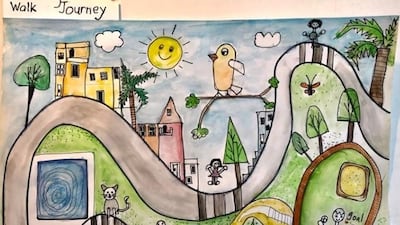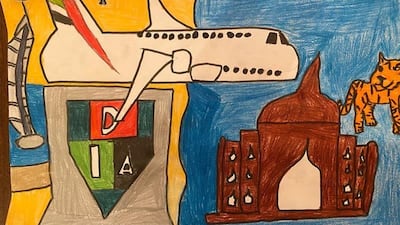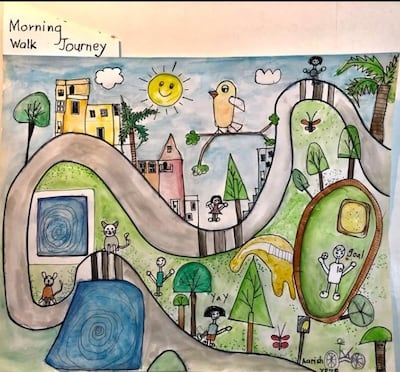A self-portrait by Mark Abdel Malak shows the fourth-year pupil with his mouth agape, shouting “let me out” in a spiked speech bubble. Half of his face is concealed behind a tie-dye-like swirl of colours, each with a word that is indicative of the times.
“Stay home” in red, “bored” in yellow, “distancing” in purple and “virus” written in the green and grey stream, complete with sketches of the Covid-19 virus structure.
The work seems to reflect on the emotions that Abdel Malek, and other students, are facing amid the coronavirus pandemic.
Abdel Malak, a student at Raffles International School, is one of 314 students whose artworks are being shown in an online exhibition by the Innoventures Education Group.
The show, which launched on Sunday, June 28, comes after an art competition that the Innoventures Education Group held across its five schools in the UAE. The annual competition, which carried out its sixth iteration this year, was held under the theme Journeys.
“Initially, the competition was going to be held under the Expo 2020 theme,” says Wafaa Mohamed, an art teacher at Raffles International School.
As the coronavirus pandemic took hold – and the Dubai Expo was pushed to 2021 – Mohamed says the theme was changed to reflect the circumstances.

“I wanted the theme to be open to interpretation, so students could express what they were going through. These are unprecedented times and they bring unique challenges, whether related to health, education or family.”
In the competition call, students were asked to reflect on a story of change and development. “Whether it’s your journey or that of someone close to you, whether it’s a journey of healing, success, evolving or empowerment. Each journey has a special significance that adds to your experiences and values.”
Another work in the exhibition is Morning Walk Journey by Aarish Kulaye, a second-year pupil at Raffles International School. It shows the walk Kulaye takes around his neighbourhood in the mornings, with triangular and lollipop-shaped trees, cheerful cats and a large droopy-eyed bird looking languidly across at a smiling sun.
The artwork is charming and imaginative, and it won Kulaye first place in the competition’s 2D category. The contest included three other categories, including 3D, photography and video art.
“Students from grades one to 13 took part in the competition,” Mohamed says. “We first held online workshops for two weeks in March, where we elaborated on the theme and helped students find materials to work with.”
As going out for art supplies was not possible, especially in the first few weeks of the pandemic, owing to strict restrictions put in place to prevent the spread of the virus, Mohamed says she advised pupils to work with whatever they could find at home.
“From markers to coffee beans and even ketchup,” she says. “The goal was to have them creatively express themselves.”
Pupils were then given a few months to work on their projects before submitting them earlier this month.
“We sat down to sort everything out and then held an online meeting on June 20, in which judges discussed the works for more than five hours and picked out the winners.”
The winning artworks were selected by a five-person jury that included established artists from Egypt, Sudan, Germany, Saudi Arabia and India.
“They each picked out their top three works and then also two others for Judges’ Awards, which are works that didn’t make it to the top three but deserved recognition anyway,” Mohamed says.








